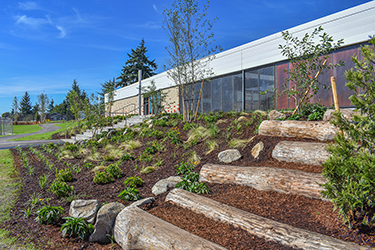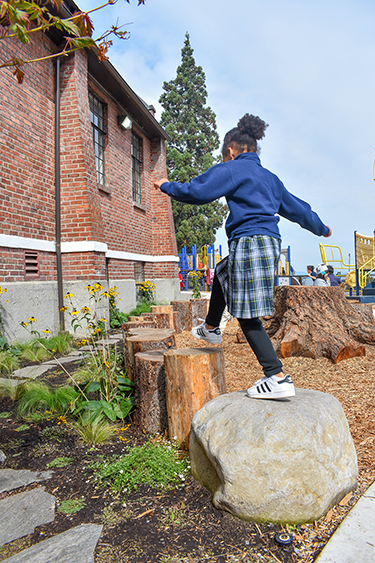|
Subscribe / Renew |
|
|
Contact Us |
|
| ► Subscribe to our Free Weekly Newsletter | |
| home | Welcome, sign in or click here to subscribe. | login |
Construction
| |
 |
August 27, 2020
Learning inside and outside the box
AHBL

Bartosh
|

Stuart
|
Outdoor learning spaces may be a critical tool in response to COVID-19. We’ve learned from lockdowns and quarantines that the outdoors offers a refuge from the rigors of isolation.
Additionally, disease — especially respiratory disease — is less able to be transferred outside than in confined spaces where air is recycled and recirculated. The flexibility of outdoor learning allows for physical distancing. Schools need to use every tool at their disposal — including outdoor learning — to limit the spread of disease and keep children safe until vaccines and treatment are developed.
With this in mind, it is worth considering the advantages of outdoor learning and environmental experiences beyond this challenging time:
• An increased connection with the natural world.
• A better understanding of seasons, flora and fauna.
• Better health and wellness, fueled by fresh air, natural light and access to exercise.
These are the goals to which landscape architects, school districts, educators and parents must aspire.
Outdoor spaces in educational environments can be more than just spaces to pass through. They can be opportunities to foster unique learning experiences. Connecting students to nature is essential. While schools all over the country have been incorporating innovative landscapes, these features tend to be the first to be cut. Considering COVID-19, perhaps that will change.
When visualizing outdoor spaces at schools, most envision asphalt basketball courts and plastic play equipment. Rarely does one think of vibrant natural environments that teach about the ecosystems and are intertwined with our everyday lives. Many schools lack any kind of natural environment, despite the impact environments have on student’s development and understanding of the world around them. Landscape architects and schools are making great strides to change the way we design and utilize our outdoor learning environments to capitalize on the innate benefits of outdoor learning.
Outdoor learning environments can take vastly different forms, from wide-open fields and wooded areas to nearby open spaces and public parks. At the Annie Wright School in Tacoma, outdoor learning was identified as a primary goal of a recent playground upgrade. In order to accommodate the school’s International Baccalaureate program and its emphasis on outdoor learning, AHBL landscape architects created a natural area to invite exploration, curiosity and creativity.
Large, old-growth stumps anchor the edges of the space and create opportunities for outdoor classroom teaching and a large wooden table and benches provides additional seating and flexible learning space nestled under an existing tree and enclosed by soft, low plantings. Framed within the beautiful brick walls of the school on three sides, the new natural area was carved out of existing spaces and has become an immediate asset.
Fife School District is undertaking just such an endeavor at Elementary School No. 4, where an outdoor learning courtyard was selected by the school district and Integrus Architects as a primary project goal. A key element in this effort is the inclusion of natural berms, created from repurposed topsoil which would have otherwise been trucked off-site during construction.
These sculpted landforms are designed for students to engage in creative and unstructured play and can accommodate classes in a socially distant, open air environment. In addition to providing a venue for play and learning, the berms are visible from three stories of classrooms, reducing stress among students and standing as a tangible reminder of nature. The use of fill material and existing space ties directly into the cost efficiency school projects demand.
As Sharon Gamson Danks notes in her article, “The Green Schoolyard Movement” (The New Nature Movement: guest columns, Feb. 6, 2014), interaction with nature reduces cortisol levels, leaving a person feeling renewed and revived for days after their nature experience. Additionally, outdoor learning can enhance student enthusiasm and engagement in learning. Hands-on experiences promote deep learning and imaginative play by providing variety and diversity in children’s social and play environments. The result is an increased ability to focus, reduction in boredom, shifts in social leadership structure, and fewer disciplinary problems such as playground bullying.
Even before COVID-19, AHBL’s landscape architects were embracing the challenge of bringing outdoor learning to K-12 clients around Washington state.
Currently, there are several barriers that can prevent schools from being able to implement these types of spaces. Funding, time demand and maintenance are three of the most prominent, but with the right approach, solutions are available.
In Tacoma, the outdoor learning environment at Arlington Elementary School benefits from using natural elements and takes advantage of nearby Oak Tree Park to enhance science curriculums. This is a great example of school districts partnering with local parks districts to capitalize on nearby open spaces while maintaining budget and programming space.
In the case of Arlington Elementary, AHBL also provided landscape architecture services for the restoration of Oak Tree Park, in which major improvements were made for accessibility and natural habitat. This project is a testament to creative problem solving and resource management. The school district has partnered with Metro Parks Tacoma and Wildlife Champions to bring the students immersive nature experiences. Partnerships with local agencies and utilizing existing open spaces are low-cost strategies to bring students closer to nature.
Outdoor learning spaces can be accommodated by almost any budget. Low maintenance options and collaboration with facilities staff ensures these assets do not become a burden to school districts. Thoughtful design can account for inclement weather and regional conditions. And while student safety remains of paramount importance, outdoor spaces can be made safe for all through thoughtful design. These are compelling solutions considering the dangers of COVID-19, made all the more attractive because of its ability to stand the test of time and bring value to students for decades to come.
For all the challenges and struggle it has created, perhaps we can make a return to nature one of the defining legacies of COVID-19.
Sarah Bartosh is a landscape designer for AHBL and James Stuart is senior marketing coordinator at AHBL.
Other Stories:
- Building schools is about building communities
- First U.S. net zero school has 10-year checkup
- How the pandemic can change education for the better
- Eastside school’s HVAC system zaps the bad stuff
- Idaho school master plan takes on Living Building Challenge
- Community engagement drives design for Tacoma school
- Modular classrooms are a quick study in filling vital needs
- Modified mechanical systems for healthier schools
- Students get a boost from outdoor connections
- UWT project focuses on equity, justice and design




